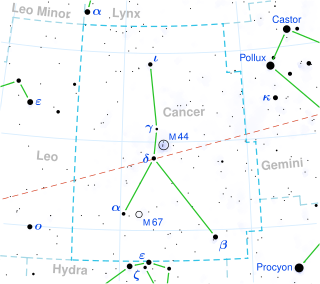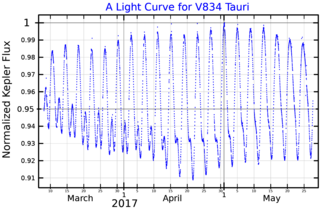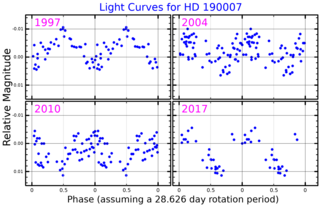
Beta Cancri, also named Tarf, is the brightest star in the zodiacal constellation of Cancer. It has an apparent visual magnitude of +3.5 and an absolute magnitude of −1.2. Based on parallax measurements obtained during the Hipparcos mission, it is approximately 290 light-years distant from the Sun. An exoplanet, designated Beta Cancri b, is believed to be orbiting the star.
Omicron Serpentis is a solitary star in the Serpens Cauda (tail) section of the equatorial constellation Serpens. Based upon an annual parallax shift of 18.83 mas as seen from Earth, it is located around 173 light years from the Sun. The star is visible to the naked eye with a base apparent visual magnitude of +4.26.

28 Andromedae is a Delta Scuti variable star in the constellation Andromeda. 28 Andromedae is the Flamsteed designation. It also bears the variable star name GN Andromedae. Its apparent magnitude is 5.214, varying by less than 0.1 magnitudes.

9 Aurigae is a star system in Auriga (constellation). It has an apparent magnitude of about 5, making it visible to the naked eye in many suburban skies. Parallax estimates made by the Hipparcos spacecraft put it at about 86 light-years from the solar system, although individual Gaia Data Release 3 parallaxes place all three components at 88 light years.

Iota Canis Majoris, Latinized from ι Canis Majoris, is a solitary variable supergiant star in the southern constellation of Canis Major. It is visible to the naked eye with an apparent visual magnitude that varies between +4.36 and +4.40. The distance to this star is approximately 2,500 light years based on spectroscopic measurements. It is drifting further away with a radial velocity of +42 km/s.

Gliese 105 is a triple star system in the constellation of Cetus. It is located relatively near the Sun at a distance of 23.6 light-years. Despite this, even the brightest component is barely visible with the unaided eye (see Bortle scale). No planets have yet been detected around any of the stars in this system.

HD 29697 is a variable star of BY Draconis type in the constellation Taurus. It has an apparent magnitude around 8 and is approximately 43 ly away.
HD 36678 is single star in the northern constellation of Auriga. This star is dimly visible to the naked eye with an apparent visual magnitude of 5.83. It is located at a distance of approximately 840 light years from the Sun based on parallax.

HD 190007, also known as Gliese 775, is a star with a close orbiting exoplanet in the constellation of Aquila. Parallax measurements by Gaia put the star at a distance of 41.5 light-years away from the Sun. It is drifting closer with a radial velocity of −30.3 km/s, and is predicted to come within 11.8 light-years in 375,000 years. The star has an absolute magnitude of 6.91, but at its present distance the apparent visual magnitude is 7.46, which is too faint to be viewed with the naked eye.

S Pegasi is a Mira variable star in the constellation Pegasus. It varies between magnitude 7 and 13 with a period of 319.22 days. It is believed to be pulsating in the first overtone. First overtone pulsators have masses less than 1.8 M☉ at a temperature of 2,107 K, and less than 1.4 M☉ at the luminosity of S Pegasi.

Delta Coronae Borealis, Latinized from δ Coronae Borealis, is a variable star in the constellation Corona Borealis. Its apparent magnitude varies regularly between apparent magnitude 4.57 and 4.69, and it is around 170 light-years distant.

Delta Sagittae is a binary star in the constellation of Sagitta, with an apparent magnitude of +3.68. The primary component is a red M-type bright giant, and the secondary is a B-type main-sequence star. It is approximately 430 light years from Earth, based on its Gaia Data Release 2 parallax.

106 Herculis is a variable star in the northern constellation Hercules. It is visible to the naked eye as a faint, red-hued point of light with a baseline apparent visual magnitude of 4.96. Based on its parallax, it is estimated to lie 383 light-years away from the Sun. The star is moving closer to the Earth with a heliocentric radial velocity of -35 km/s.

28 Monocerotis is a single star in the equatorial constellation of Monoceros. It has an orange-hue and is faintly visible to the naked eye with an apparent visual magnitude of 4.69. The distance to this star is approximately 450 light years based on parallax, and it has an absolute magnitude of −1.00. The star is drifting further away from the Sun with a radial velocity of +26.7 km/s.
Mu Muscae, Latinized from μ Muscae, is a solitary star in the southern constellation of Musca. It is visible to the naked eye as a faint, orange-hued star with an apparent visual magnitude of around 4.75. Based upon an annual parallax shift of 7.21 mas as seen from Earth, it is located about 450 light years from the Sun. The star is drifting further away with a radial velocity of +37 km/s.

QZ Puppis is a class B2.5V star in the constellation Puppis. Its apparent magnitude is 4.5 and it is approximately 650 light years away based on parallax.

R Geminorum is a Mira variable and technetium star in the constellation Gemini. It is located approximately 850 parsecs (2,800 ly) away.

Z Ursae Minoris is a carbon star and R Coronae Borealis variable in the constellation Ursa Minor.

25 Serpentis is a star system in the constellation of Serpens Caput. With an apparent magnitude of 5.37, it is just barely visible to the naked eye. The system is estimated to be some 450 light-years based on its parallax.

6 Geminorum is a variable star in the zodiac constellation of Gemini, located roughly 5,800 light years away from the Sun. It has the variable star designation BU Geminorum; 6 Geminorum is the Flamsteed designation. At its brightest this reddish hued star is barely visible to the naked eye but is readily visible with binoculars, found southeast of M 35, just to the south of WY Geminorum. It is moving further from the Earth with a heliocentric radial velocity of +27 km/s. The star is a member of the Gemini OB1 association.

















